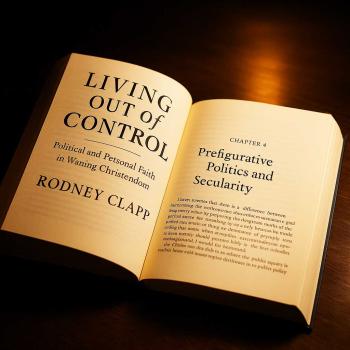To here I have discussed folk religious expressions of atonement that are not completely wrong but incomplete or at least prone to distorted understanding and two recent books that I find helpful in developing an understanding of atonement that keeps in touch with evangelical tradition (which has without doubt emphasized penal substitution) while seeking to correct its mistakes. Those books are Hans Boersma, Violence, Hospitality and the Cross and Scot McKnight, A Community Called Atonement.
Both of these contemporary evangelical thinkers attempt to rescue penal substitution from its critics while acknowledging some validity in the criticisms (at least of some of the critics). Both attempt to place penal substitution (or penal representation as Boersma prefers) within a larger framework of multiple biblical metaphors and historical theories of atonement. To use Scot’s analogy, for both of them, penal substitution is a necessary club in the bag of golf clubs but not the only one.
I’ve hinted at extreme versions of penal substitution that are to blame for much of the criticism brought against it. Another, older book that lays this out helpfully is The Atoning Death of Christ by Ronald Wallace (Crossway, 1981). Wallace quotes Protestant scholastic theologian Stephen Charnock who reveled in the gross infliction of pain and suffering on Jesus by the Father. For example, Charnock wrote that “He [the Father] was desirous to hear him [Jesus] groaning, and see him bleeding… He refused not to strike him that he might be well pleased with us; quenched his sword in the blood of his son that it might be for ever wet.” Charnock also wrote that God let his justice “fly upon” Christ, “to have its full pennyworth out of him. He lets wrath suck the blood of his soul, till it falls off, as the leech when it is filled and breaks.” Finally, another Protestant scholastic, Thomas Goodwin, wrote of Jesus “being made a common drain and sink into which all the sins of every particular man do run, and the centre [sic] in which they all meet; and that meeting implies an assembly of particular sins.” (All this is on page 84)
Wallace, a Calvinist himself, criticizes Protestant scholastics such as these for their way of presenting the penal substitution theory: “The way the theory was presented gave difficulties of conception that smacked of unreality.” (85) Wallace goes on to discuss the atonement theology of R. W. Dale, an English congregationalist of the turn-0f-the-century (1900-1901), that attempted to preserve the truth in penal substitution while discarding the Protestant scholastic distortions. Dale depicted the atonement not as the Father taking out his wrath on the innocent victim Jesus but as God himself suffering the consequences of human rebellion and forgiveness. He thought of Jesus as in solidarity with all of humanity so that on the cross he represented all sinners. About as far as Dale would take it is that sin has consequences and Jesus, as God, suffered those consequences for us. Also, forgiveness is costly, not easy, and the forgiving one always suffers that cost. Dale was responding to Scottish theologian J. McLeod Campbell who famously rejected penal substitution in favor of his own theory that C. S. Lewis embraced in Mere Christianity and called “the perfect penitent” theory. Campbell’s theory had caught on among many British congregationalists as an alternative to the Protestant scholastic atonement theology that American theologian Harry Emerson Fosdick referred to often as “slaughterhouse religion.” Dale was part of a moderately evangelical congregationalist movement of theologians who sought earnestly to rescue something of penal substitution from its distorted expressions.
Wallace’s book is somewhat outdated now; it certainly doesn’t take into account developments in atonement theology during the last quarter century, but I still think it’s a helpful critical survey of atonement theology throughout Christian history–up to the 1980s. I suppose it is out of print–like too many good books. But you can probably buy used copies on line.
Another older book on atonement, also now unfortunately out of print, is The Death of Christ by my friend Fisher Humphreys (Broadman, 1978). Humphreys recently retired from Beeson Divinity School at Samford University. He and I share some common history. We both studied under Sam Mikolaski who wrote his dissertation at Oxford under Leonard Hodgson (author of The Doctrine of the Atonement and many other good books of theology).
Humphreys does attempt to carve out an alternative to penal substitution. (I don’t know if that had anything to do with his leaving New Orleans Baptist Theological Seminary or not, but it wouldn’t surprise me.) Humphreys’ alternative is what he calls “cruciform forgiveness” and “costly forgiveness.” To quote one sentence from the book “…the route to forgiveness has been characterized [in this book] by the bearing of certain painful experiences. It is therefore somewhat costly.” (142) I think the essence of Humphreys’ theory is summed up on page 153: “In Christ we have seen God accepting the pain our sins cause him as good, but more; accepting the pain our sins cause him as loving us, but more; accepting the pain our sins cause him as our victim, but more: in Christ we have seen God accepting the pain our sins cause him as voluntary victim. He did and does this in order to bring us back to himself.”
Humphreys’ theory of the atonement is an extension of Horace Bushnell’s and he gives Bushnell credit. But it is not just Bushnell’s theory expressed in more modern language. Humphreys helpfully clears up some problems in Bushnell’s theory that made it SEEM (whether it was intended to or not) to be a version of Abelard’s subjective theory. In the end, however, I still wonder why costly forgiveness had to involve the death of Jesus. Does Humphreys’ theory actually answer the question inquiring minds want to know “Why did Jesus have to die?” Still, I find Humphreys’ theory much, much better than any other alternative to penal substitution and it is the one I have often fallen back on when penal substitution just doesn’t seem to work. In the end, however, I think real progress has been made toward “fixing” the problems of penal substitution theory–by theologians such as Dale and Boersma and McKnight.
Sometime in the near future, I cannot predict exactly when, I want to finish this series on atonement with an extended critical interaction with Recovering the Scandal of the Cross, second edition, by Mark D. Baker and Joel B. Green. This book, perhaps more than any other by evangelicals, has stirred controversy among evangelicals. Is the controversy justified? That’s what I want to consider now that the second edition is out. I have read it once, but I want to give it a close second reading before responding.











